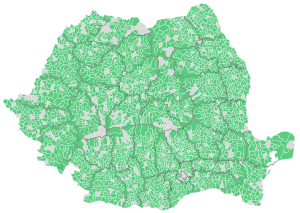
 |
|---|
A commune (comună in Romanian) is the lowest level of administrative subdivision in Romania. There are 2,686 communes in Romania. The commune is the rural subdivision of a county. Urban areas, such as towns and cities within a county, are given the status of city or municipality.
In principle, a commune can contain any size population, but in practice, when a commune becomes relatively urbanised and exceeds approximately 10,000 residents, it is usually granted city status. Although cities are on the same administrative level as communes, their local governments are structured in a way that gives them more power. Some urban or semi-urban areas of fewer than 10,000 inhabitants have also been given city status.
Each commune is administered by a mayor (primar in Romanian). A commune is made up of one or more villages which do not themselves have an administrative function. Communes, like cities, correspond to the European Union's level 2 local administrative unit (LAU).
Florești, in Cluj County, is the largest commune in Romania by population, with over 22,000 inhabitants.[1][2] Bistra, in Alba County, is the largest commune in Romania by surface area, covering an area of 138 km2 (53 sq mi).[3] Other sources list Nucșoara, in Argeș County as the largest commune in Romania; this commune covers an area of 437.09 km2 (168.76 sq mi).[4]
See also
[edit]References
[edit]- ^ "Florestiul, comuna cu cea mai mare populatie din Romania | Citynews Cluj". Archived from the original on 2014-06-16. Retrieved 2014-06-17.
- ^ Cea mai mare comună din țară își face universitate cu 10 milioane de euro. Cu ajutorul penticostalilor | adevarul.ro
- ^ Țimonea, Dorin (November 18, 2019). "Cele mai întinse și cele mai mici orașe din România. Câți oameni trăiesc în localități de sute de kilometri pătrați". Adevărul (in Romanian). Retrieved May 9, 2020.
- ^ "Prezentarea comunei Nucșoara". primarianucsoara.ro (in Romanian). Nucșoara townhall. Archived from the original on December 9, 2021. Retrieved June 29, 2021.
Well, that’s interesting to know that Psilotum nudum are known as whisk ferns. Psilotum nudum is the commoner species of the two. While the P. flaccidum is a rare species and is found in the tropical islands. Both the species are usually epiphytic in habit and grow upon tree ferns. These species may also be terrestrial and grow in humus or in the crevices of the rocks.
View the detailed Guide of Psilotum nudum: Detailed Study Of Psilotum Nudum (Whisk Fern), Classification, Anatomy, Reproduction